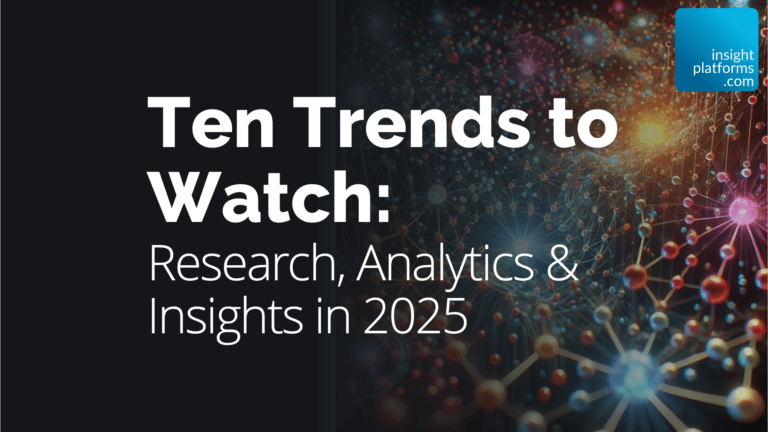
Ten Trends in Research, Insights & Analytics for 2025
By Insight Platforms
- article
This article is a brief synopsis of the main points from our 10 trends webinar originally presented in December 2024.
Watch the full webinar replay here:
AI-assisted technology keeps reshaping what is possible in research and analytics.
In this post, I’ll unpack the ten essential trends that emerged from our recent webinar, with a closer look at how they are redefining the insights industry in the coming year and beyond.
Stay up to date
Subscribe to receive the Research Tools Radar and essential email updates from Insight Platforms.
Your email subscriptions are subject to the Insight Platforms Site Terms and Privacy Policy.
1. The Rise of Real-Time Voice
Imagine a qualitative research interview, not led by a human but by an AI that can empathetically engage with human emotions, all in real time. This isn’t fantasy, it’s already happening and rapidly gaining momentum. Tools like ChatGPT’s Real Time Voice interaction let us have rich, human-like conversations, bringing automated moderation a step closer to human interviewing.
2. From Words to Multimodal Understanding
One academic study asserts that only 7% of conversational meaning comes from words. 55% is non-verbal – facial expressions, body language, and context – and 38% derives from tone of voice. So far, conversational AI has only scratched the surface, largely missing out on ‘unspoken; meaning. Enter multimodal AI, which pairs language models with computer vision, audio, and even emotion AI capabilities to decode those silent signals that guide behaviour – with big implications for online video interviews, mobile ethnography, and usability research.
3. Talking to Data
Analysing data is becoming much more accessible as LLM-powered chat interfaces make it easy to query both qualitative and quantitative data sets. Whether it’s survey responses, interview transcripts, or analytics data, conversational analysis is helping to create reports in real-time and make insights more broadly accessible. For more examples of this, watch the on-demand sessions from the Analytics & Reporting Summit with platforms like Glimpse, Caplena and Sago QualBoard.
4. Automation 2.0: Beyond Efficiency
AI-led automation is no longer just about efficiency – it’s reinventing processes and finding new ways to generate value. Solutions from MX8 Labs and Cursory Tech transform survey creation by using AI to convert messy Word documents into ready-to-use surveys. Focaldata and Knit have solutions that automate every stage of the research process: brief creation, survey design analysis planning, fieldwork, and final reporting. One Strategy Studio has built AI co-workers that do all the heavy lifting for semiotics, brand positioning, and idea generation briefs.
5. Battling Fraud in a New Era
With AI’s rise comes the shadow of fraud. Before long, AI-generated digital avatars will be able to mimic real survey participants, compromising data reliability. Tools like RealEyes Verify counter this with biometric verification and real-time checks. As fraud evolves, defences against it will need to improve as well.
6. The Era of Synthetic and Agentic Data
Synthetic data, AI-generated and modelled, has become an essential tool, not just a concept. Combined with human insights, researchers can quickly create digital twins of consumers, offering deep behavioural insights and enhancing predictive capabilities. Taken a step further, companies like Vurvey and Zappi have built AI agent processes that connect virtual teammates together in workflows for innovation or creative development. Trained on both external and internal company data, a virtual consumer may help a virtual concept writer generate ideas that are refined by a virtual product manager – and then tested again with virtual consumers. Design, compliance, and marketing innovation processes are all set to run much faster.
7. Insight Synthesis: Speeding Up the Desk Research Process
Desk research, once painstaking, has been revamped by tools like Talio and Deep Research models from Google Gemini, ChatGPT and Perplexity. These solutions may not be perfect, but they will help to speed initial reporting to understand topics, audiences and markets.
8. Embedding Insights Across Organisations
The era of siloed insights is ending. Modern tools embed insights into daily workflows, making data more actionable at the point of need. In product research, for example, designers using platforms like Figma are testing their concepts in real-time with integrated user feedback tools like UserTesting or Maze. Solutions like Market Logic Software and Stravito help to embed consumer insights directly in the workflows and tools of marketing, innovation and executive teams.
9. Agencies at a Crossroads
As technology evolves, so do agencies. Research tech firms have long been seen as a challenge to agencies: if clients can ‘in-source’ activity with a software tool, what value do agencies bring? Undoubtedly some agencies have suffered. But those with strong insights, expertise, category knowledge, and client context are using these strengths to develop their own tech products. The line between an agency and a tech firm is becoming ever more blurred.
10. The Explosion of Research Activity
All these tools and AI developments have the effect of reducing friction in the insights process. This means that research, insights, and analytics are more available to more people than ever before. However, for in-house insight teams, this poses a dilemma. Demand for insights will keep increasing – but headcount and discretionary budget will not grow at the same pace. Teams will need to reinvent their operating model to meet this ever-growing demand.
Watch the webinar to understand more about each of these trends and see some of the leading companies driving developments.


